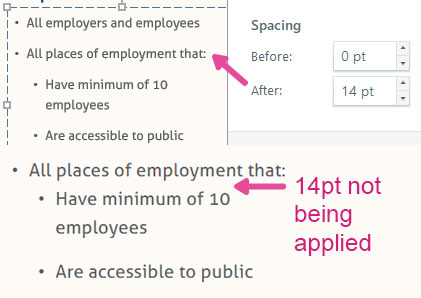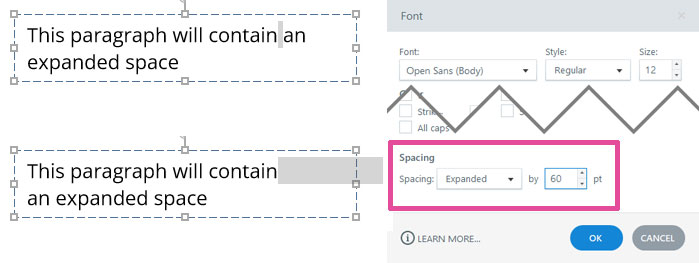Electronic Accessibility
Laying Out Text in Storyline
Last updated: 5/26/2025
After paragraph spacing issue

It's been observed in newer versions of Storyline that the After paragraph spacing setting doesn't always work as intended, especially with indented list items.
If you find that an attempt to create spacing between two paragraphs using After paragraph spacing is not working, instead of giving the former paragraph After paragraph spacing, give the latter paragraph Before paragraph spacing.
Line breaks and text wrapping
When laying out text within Storyline, be cautious of using soft breaks: that is, creating a break by pressing the Shift + Enter keys together.
In most cases, using a soft break will cause a <br /> (line break HTML tag) to be added to the source code. While these tags shouldn't disrupt semantic structure — for example, in the screenshot below, you can see how NVDA recognized the full link and full heading and did not create separate elements at the soft breaks — they may impact how screen readers interpret content in certain conditions. For instance, if screen reader users are reading through a slide using read forward commands, their screen readers may stop reading at the <br />, necessitating additional command inputs, and may reannounce heading or link structure, creating the impression of separate elements.

Other methods for controlling where text will wrap to the next line
Text box/element width
Will changing the width cause text to wrap where you want?
If so, this method tends to be easiest to implement and has little to no impact on the learner experience.
Expanded spaces
This method uses the Spacing font setting.
Select the space where you want the text wrap to occur, open the Font panel. and set the Spacing to Expanded, with a value that will make the space wide enough to push the word after it to the next line of text.

This method will not impact how screen readers read the content, in most cases, but:
- It may lead to unintended and disruptive visual layouts for learners who manually change font and spacing settings using browser extensions and custom style rules
-
It does not work with links; it may create an undesirable visual appearance and, more importantly, will cause the link to be semantically recognized as separate links, divided at the point of the expanded space, often with a third unlabeled link, all of which could be considered a WCAG 1.3.1 Info and Relationships (A) failure

